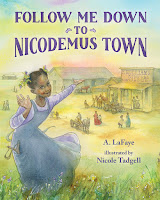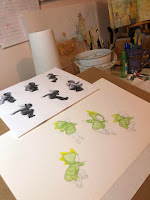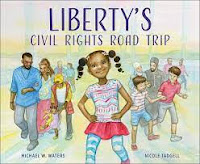Today I want to welcome picture book author and poet, Matt
Forrest Esenwine
http://mattforrest.com/ Matt started out in radio, working behind the
scenes and on the air. He still maintains a career as a voice actor. But the
publication of one of his poems in a college journal when he was just a high
school student led to a passion for poetry that’s never waned.
Matt has written poems for adults and children. His lighthearted
verses have appeared in prestigious children’s magazines such as Highlights, and
in numerous collections including many edited by the renowned Lee Bennett
Hopkins. Matt’s picture books include the spooky Flashlight Night and
the rollicking Don’t Ask a Dinosaur, which was co-authored by
Deborah Bruss. Once Upon Another Time, co-authored by Charles Ghigna,
will be out in 2021. And I hear there is a lot more to come. I can’t wait!
What draws you to poetry, Matt?
I always tell people
that one of the main reasons I love poetry is that you can say so much in a
tight, compact little package. A poem can be full of imagery, emotion, wit, and
beauty – and you don’t need 500 pages, or even 32. And with my attention span,
I love that I can write a short little scene in just a few lines and then move
on to something else!
Is it difficult to get published as a poet? Is it true that
many editors discourage submissions of rhyming picture book texts? How do you
approach marketing your work?
It is difficult, but
I think the more you get your name and work out there, the easier it gets. I’d
been writing poetry since I was in high school, but had never been published as
a children’s writer, so it took some effort to show decision-makers what I
could do. A lot of beginning children’s poets feel that they need to write
silly poems, or write poems that rhyme, or use simple words…and none of that is
necessarily true. There’s a wide variety of poetry out there for kids and the
one thing you don’t want to do is try
to be the next Shel Silverstein or Dr. Seuss. Be your own writer and develop
your own unique style.
As for editors, it’s true that many discourage rhyme, but that’s because they
see so much bad rhyme: words that are simple or expected rhymes; slant rhymes,
which are words that almost rhyme but don’t quite (man/hand, down/loud,
can/pans); words that are used only for the sake of the rhyme and not to move
the story forward; and uneven rhythm/meter. So in my cover letters, I rarely
tell editors I have a rhyming PB, lest they develop a preconceived negative
expectation – I just say it’s a PB and let them read it for themselves!
I created my blog
back in 2012 as a way of showcasing my abilities – knowing how difficult it
would be to promote my poetry – so that has been a very useful means of
marketing. Taking part in online events like #PoetryFriday and #PBPitch has
helped me promote and market my writing, and I’m very active on social media,
which also helps tremendously. Moreover, having spent 25 years in radio as an
on-air personality as well as a commercial production director, I’ve learned a
lot about advertising!
Do you have any suggestions for those of us, like me, who’d
like to sharpen our poetic skills?
I’d say the first
thing anyone should do is read, read, read! As I mentioned earlier, so many
folks just getting started are unfamiliar with the variety of children’s poetry
out there: the witty rhyming poetry of
Douglas Florian, the understated simplicity of Charles Ghigna, the emotional
insight of Nikki Grimes, the variety of voice and style of Jane Yolen. And
there are so many others! Joyce Sidman, Marilyn Singer, J. Patrick Lewis,
Rebecca Kai Dotlich…the list goes on and on, and that doesn’t even include the
long list of past children’s poets who have come before us.
As for honing one’s
craft, I suggest paying attention to the story or scene; don’t just rhyme a
word because you need a rhyme, don’t use words or imagery that a reader might
already anticipate, and definitely pay attention that you’re not speaking down
to the reader. Kids are smarter than you think! In fact, don’t even worry about
rhyming in the first place –free verse poetry is a wonderful (and quite
popular) option, and is a great way for beginning poets to practice learning
their subject and honing their skills without worrying about rhyme and meter.
What suggestions do you have for teachers who’d like to
share poetry with their students?
Again, introducing
children to a variety of poetry is crucial, because I think the reason many
adults don’t appreciate poetry is because they were never introduced to the
right ‘kind’ of poetry – that is, poetry they actually enjoy – as children. People who love Shakespeare might not like the
work of Charles Simic; those who love poetry slams probably can’t get into Robert
Frost. But it’s all poetry, whether it’s Jack Prelutsky or Kwame Alexander! A
few books I recommend:
•
Catch Your
Breath: Writing Poignant Poetry, Laura Purdie Salas (Capstone, 2015)
•
Poems Are
Teachers: How Studying Poetry Strengthens Writing in All Genres, Amy Ludwig
VanDerwater (Heinemann, 2017)
•
Poem-Making:
Ways to Begin Writing Poetry, Myra Cohn Livingston (HarperCollins, 1991)
•
Strange
Terrain: A Poetry Handbook for the Reluctant Reader, Alice B.
Fogel (Hobblebush Books, 2009)
You were one of the judges for the new poetry collection, Friends and Anemones. How did it feel to be on the other side of the
desk, selecting poems instead of submitting them?
It was definitely an
unusual experience! I’ve critiqued poems and manuscripts through critique
groups and the SCBWI, but never in this particular situation. Kip and I used a
spreadsheet program to vote 1, 2, or 3 (1 was yes, 2 meant good but needed
work, 3 meant likely not) and then the editors compared our notes to theirs and
we moved forward.
You wrote
Don’t Ask a Dinosaur and
Once Upon
Another Time with co-authors. What was that like? How did you share in the
creation of these books?
Jane Yolen has said
in the past that co-authored books are twice the work and half the pay – which
is funny, but true! However, the experience is extremely gratifying, as well,
because you get twice the insight and joy of watching your baby grow with both
“parents.” For each of these books, I was given the germ of an idea by my
co-author, spent a great deal of time considering narrative possibilities,
wrote the initial rough draft, and then worked with the co-author on 20 or so
revisions before we’d finally polished it to the point of being
submission-ready.
Even after the manuscripts
were picked up by their publishers, it was a great deal of fun working on
editorial revisions, bouncing ideas of each other and seeing what surprising,
creative solutions we’d come up with. I’m actually in the process of submitting
a poetry collection that is also a collaboration with a highly esteemed
children’s poet, so fingers crossed!
Flashlight Night was unique in many ways. You
wrote it in second person, a device that invites the reader to participate in
its adventure. You also the worked closely with illustrator in creating the
book. How did this book evolve?
I wrote the
manuscript after a long drive at night, when all I could see were my car’s
headlights. The phrase, “Flashlight…opens up the night” popped into my head,
and I had no idea what to do with it. So I worked on it as I continued my drive
home and eventually nailed it down after a couple of weeks. I deliberately
wrote it in such a way as to have the reader as the person on the adventure –
there’s no “Billy did this” or “Sally said that” – there are no characters
mentioned at all, save for the flashlight!
It’s interesting to
note that a published author critiqued the manuscript and had a number of
concerns, including: a) I was using 2nd
person POV; b) flashlights show reality, not imagination, c) a tomb was too
scary for kids, and d) I needed a better opening line. Good thing I stuck with
my instinct, or we wouldn’t have a book to talk about!
Illustrator Fred
Koehler are Facebook friends, but we didn’t work together directly…although you
might think we did! The seamlessness of text and picture are all due to editor
Rebecca Davis’ magical juggling handiwork, keeping Fred and I apprised of what each
of us was doing. At one point, there was one scene where Fred had a lot going
on in a spread, but Rebecca felt it was taking the reader away from my
narrative, so she had to “reel him in,” so to speak – but there was another
part in the book where his sub-narrative of the flashlight showing the story
didn’t really mesh with my initial ending, so I had to slightly alter my text
to better match his vision. In the end, Rebecca’s work made for a beautiful
blend of art and text, and the book has even been used as a mentor text for
that very reason.
Once Upon Another Time is coming out in March 2021
.
How exciting! What is it about?
It’s a poetic look at the natural world
around us, what it used to be like before humans made their mark, and how we
can all experience that world again. Charles Ghigna (aka, “Father Goose®”)
initially shared with me the first 4 stanzas he’d written back in 2012; not
knowing where to go with them, he asked if I had any ideas. So I thought about
it for a while and came up with a proposal for a storyline, and sent it to him
along with 4 more stanzas so he could get a sense of what I was thinking.
Charles couldn’t believe how closely our writing styles matched, and suggested
I finish writing the rough draft.
So that’s what I did! And after about a
dozen revisions back-and-forth, we began sending it out. A lesson in tenacity
and persistence to those who are just starting their publishing careers: our manuscript was rejected at least 25 times
before getting picked up by editor Naomi Krueger at Beaming Books. Twenty-five
times – and that’s with the gravitas of Father Goose’ name attached to the
project! So if you send out a manuscript once or twice and it goes nowhere,
don’t give up!
You have an incredible number of other books in the chute. (Something
like eight, right?) Certainly, something to look forward to in the future! Tell
us more!
Yes, eight more books
under contract, including a board book to kick off the new year, Elliot,
the Heart-Shaped Frog (Rainstorm
Publishing, 2021). I have two other board books on the way (possibly this
year), a few more picture books, and a poetry collection I’m eager to talk
about – but can’t yet!
Wow! That’s extraordinary! Is there anything else you’d like
to share with our readers?
I would just say that
if you’re considering writing for children, do your homework and read as much
as you can – not only to get a sense of the varieties of storytelling and books
out there but to get a sense of the market. Learn as much as you can about
craft, the industry, and the people already doing what you want to do. What’s
that saying, “if you want to get better at something, surround yourself with
people who are better at it than you?” That’s absolutely true! It’s what I did,
reaching out to as many folks as I could
through social media as well as through the Society of Children’s Book Writers
& Illustrators (SCBWI).
In fact, I tell
people I owe my entire career to lunch.
I was attending my first SCBWI conference in 2011, and while chatting during
lunchtime with my New Hampshire neighbor, the late Tomie dePaola, and SCBWI
co-founder Lin Oliver, I mentioned that I write poetry. Lin told me I needed to
contact the late Lee Bennett Hopkins, since he was “the” children’s poetry guy!
I had no idea who Lee was, but we eventually connected and he was so taken with
my work he said he’d do what he could to help me with my career. He eventually
introduced me to his longtime friend, Rebecca Davis, who would become my Flashlight Night editor and the editor
for several of Lee’s poetry anthologies to which I’ve contributed.
So don’t forsake
networking, don’t forsake learning the craft, don’t forsake revisions – and keep at it!
Thank you so much for being my guest today. Whether you’re
interested in Matt Forrest Esenwine’s work as a children’s author or a voice
actor, you can find out more at http://mattforrest.com/.

 The scope of your work is amazing. Your characters come from so
many cultures and eras. Do you actively pursue projects that represent humanity’s variety? Not
yet! I do have ideas on writing my own stories, hopefully this will come to
pass soon.
The scope of your work is amazing. Your characters come from so
many cultures and eras. Do you actively pursue projects that represent humanity’s variety? Not
yet! I do have ideas on writing my own stories, hopefully this will come to
pass soon.

































